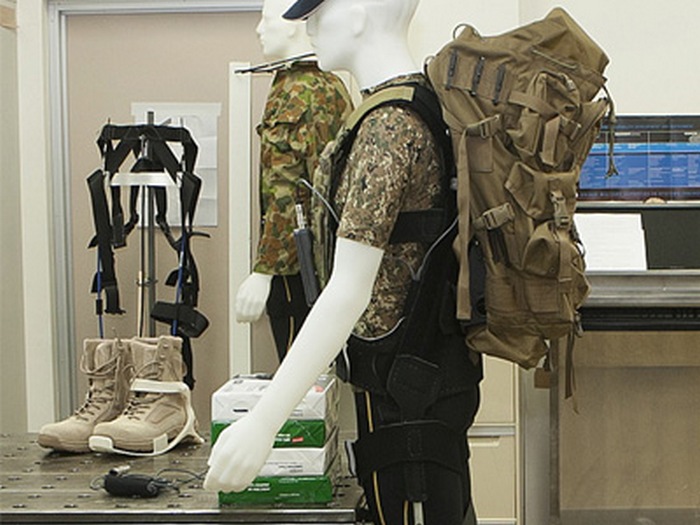Is Australia’s Minimalist Exoskeleton Tech A Step Towards a Real Iron Man Suit?
Exoskeleton technology is nothing new. Also known as a powered armor, exosuit, and exoframe, exoskeletons (the non-insect-related type) are mobile machines worn by a person to enhance strength and endurance. They typically consist of a system of motors, pneumatics or hydraulics, a power source, and other related technology. They can be used in working at dangerous environments and for military purposes. However, until now the technology has not been widely used. There have been a number of prototypes created for military use, particularly those from Lockheed Martin, Sarcos, and HULC, but they have yet to see actual deployment.
For the longest time, powered exoskeletons were relegated to being hobbies of billionaires or props for science-fiction movies. There are still too many drawbacks to put them into more useful applications like clearing up debris during disasters or serving as armors/weapon suits for the military.
Disadvantages of Traditional Powered Exoskeletons
Currently, there are still a number of limitations and issues in the exoskeletons developed so far. One of the biggest limitations is the power supply. Battery technology at present could not support the massive power consumption requirements of the exoskeletons. Non-rechargeable primary cells can store more energy compared to rechargeable ones but replacing them is quite a hassle. Internal combustion engines were considered as the power source but they are generally inefficient. There were also models that involve a separate large power source tethered to the exoskeleton but these don’t appear viable especially for military use.
Aside from the power source drawback, there are also major challenges when it comes to the actuators, joint flexibility, and the material used for the skeleton. It’s difficult to build exoskeletons with the right precision without having to deal with weight and dimensions limitations. It’s still difficult to construct an exoskeleton that can achieve the same range of movements that the human body is able to do. Most of the powered exoskeletons developed at present are still power-hungry, heavy, and awkward to use.
Australia’s Exoskeleton Tech
Things may start changing soon as Australia’s Defence Science and Technology Organisation (DSTO) introduces its minimalist and more efficient version of the technology. Formerly known as NoREx, DSTO presents the Operations Exoskeleton with its new design and improvements aimed at addressing the drawback associated with traditional electro-mechanical exoskeletons.
DSTO’s exoskeleton does not require power. Still, it is able to augment its wearer’s physical strength. It reduces physical strain and nearly eliminates the possibility of suffering fatigue or getting injured while working with heavy loads. It can make heavy burdens light without requiring power and advanced electronic components.
DSTO’s Operations Exoskeleton weighs only around 3 kilograms but is able to support weights of up to 50 kilograms.
How Does It Work?
This exoskeleton from DSTO features of a system flexible cables that passively ease out weight by transferring a considerable amount of it directly to the ground. While it is not as powerful and advanced as the Ironman suit of the United States Army, it still effectively reduces weight burdens. The flexible cables are referred to as Bowden cables that are attached to a rigid backpack frame. These cables are connected to the back, legs, and the base of the exoskeleton to channel the load fore directly to the ground.
Advantages of the DSTO Exoskeleton
The advantages are anchored on the exoskeleton’s simplicity. It is not powered so it does not require the added bulk of the batteries or engines used in powered exoskeletons. It is easier to wear and instantly works when worn. Additionally, it is designed to be more comfortable for the human body and to be moveable to most extents that the human body can move. Also, it costs lower and is easier to integrate with other equipment.
![By DonSimon (Own work) [CC0], via Wikimedia Commons](https://techtheday.com/wp-content/uploads/2014/04/walking-assistance-exoskeleton.jpg)
Photo of sample exoskeleton not related to DSTO. Image credit: DonSimon (Own work) [CC0], via Wikimedia Commons
Applications
Obviously, since it is being developed by Australia’s Defence Science and Technology Organisation, it is primarily meant to be used by soldiers. It is useful in carrying heavy weights as well as in stabilizing the body to do more precise shots when using weapons. However, this exoskeleton may also be used in other fields. It can be used by firefighters, by adventure seekers for trekking, and by ordinary individuals for carrying heavy loads. It may also be used as a form of assistive technology.
![By Copyleft (Own work) [CC-BY-SA-3.0 (http://creativecommons.org/licenses/by-sa/3.0)], via Wikimedia Commons](https://techtheday.com/wp-content/uploads/2014/04/robotic-exoskeleton.jpg)
Photo of bulkier exoskeleton sample. Image credit: Copyleft (Own work) [CC-BY-SA-3.0 via Wikimedia Commons
Availability
Reports say that this technology could be available in the next two years. The official news release of DSTO, however, says that it is still at the proof-of-concept stage and extensive requirements in the biomechanics aspect are still needed to ensure this exoskeleton’s usability and reliability. Nevertheless, early tests have shown encouraging promising results.
Unfortunately, this exoskeleton is still millions of miles away from achieving a real Iron Man suit. While it addresses the power and bulk issues of other exoskeletons, it is far from being powerful and agile enough to be close how the fictional Iron Man suit works. Hopefully, smaller but more powerful batteries and engines can be created soon and the issues involving the actuators and joint flexibility are addressed so a more powerful, reliable, and useful exoskeleton can already be created.
